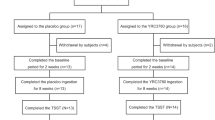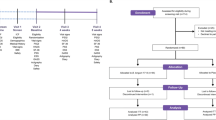Abstract
Objective:
To examine the effects of αs1-casein hydrolysate on females with stress-related symptoms.
Design:
Double-blind, randomized, crossover, placebo-controlled trial.
Setting:
The αs1-casein hydrolysate was manufactured by INGREDIA (Arras, France) and the placebo was manufactured by DIETAROMA (Bourg, France). Study was designed and performed at PROCLAIM (Rennes, France), and the statistical analyses were performed by D Desor (Nancy, France).
Subjects:
A total of 63 female volunteers suffering from at least one disorder that may be related to stress such as anxiety, sleep problems and general fatigue.
Interventions:
A total of 63 volunteers participated in a double-blind, randomized, crossover, placebo-controlled study. Subjects were randomly allocated to receive either tablets containing αs1-casein hydrolysate or placebo at the dose of 150 mg/day for 30 days. After a 3 weeks washout period, they were crossed over for a new 30-day period of tablets intake. The outcome measure was a questionnaire including 44 items of symptoms that may be related stress in which the severity of each sign was evaluated using a 10-degree scale. These measures were studied repeatedly at the day of 0, 15 and 30 after the start of each interventional period.
Results:
The 30-day treatment by αs1-casein hydrolysate in females with stress-related symptoms reduced their symptoms, particularly in digestion (P<0.01), cardiovascular (P<0.05), intellectual (P<0.01), emotional (P<0.05) and social problems (P<0.05).
Conclusion:
This study showed that a 30-day ingestion of αs1-casein hydrolysate decreased the stress-related symptoms in females suggesting that this product may be used as an effective functional ingredient alleviating such symptoms.
Sponsorship:
This study was partially supported by the INGREDIA of France and Neurobiology Research Program from the Korea Ministry of Science and Technology (2004-01757) of Korea.
This is a preview of subscription content, access via your institution
Access options
Subscribe to this journal
Receive 12 print issues and online access
$259.00 per year
only $21.58 per issue
Buy this article
- Purchase on Springer Link
- Instant access to full article PDF
Prices may be subject to local taxes which are calculated during checkout

Similar content being viewed by others
References
Berk M, Dodd S (2005). Antidepressants and the placebo response. Hum Psychopharmacol 5, 305–307.
Boiten FA, Frijda NH, Wientjes CJE (1994). Emotions and respiratory patterns: review and critical analysis. Int J Psychophysiol 17, 103–128.
Buguet A, Bourdon L, Canini F, Cespuglio R, Padomski M (1994). Sommeil et stress: exercise physique et environment extreme. Revue Scientifique et Technique de la Defense 41, 187–198.
Cacioppo J, Malarkey W, Kiecolt-Glaser J, Uchino BN, Sgoutas-Emch SA, Sheridan JF et al. (1995). Heterogeneity in neuroendocrine and immune response to brief psychological stressors as a function of autonomic cardiac activation. Psychosomat Med 57, 154–164.
Carlson NR (1994). Physiology of Behavior. Allyn and Bacon: Massachusetts, pp 359–361.
Chabance B, Jollès P, Izquierdo C, Mazoyer E, Francoual C, Drouet L et al. (1995). Characterization of an anti-thrombotic peptide from κ-casein in newborn plasma after milk ingestion. Br J Nutr 73, 583–590.
Clare DA, Swaisgood HE (2000). Bioactive milk peptides: a prospectus. J Dairy Sci 83, 1187–1195.
de Quervain DJF, Roozendaal B, McGaugh JL (1998). Stress and glucocorticoids impair retrieval of long-term spatial memory. Nature 394, 787–790.
Engler MB, Engler MM (1995). Assessment of the cardiovascular effects of stress. J Cardiovasc Nurs 10, 51–63.
Ferreri M, Von Frenckell R, Mirabel V, Tawil S, Alby JM (1988). A new scale of quantitative and qualitative evaluation of anxiety: the Ferreri Anxiety Rating Diagram (FARD). Encephale 14 (5), 385–393.
Hamilton M (1967). Development of a rating scale for primary depressive illness. Br J Soc Clin Psychol 6, 278–296.
Hotta M, Shibasaki T, Arai K, Demura H (1999). Corticotropin-releasing factor receptor type 1 mediates emotional stress-induced inhibition of food intake and behavioral changes in rats. Brain Res 823, 221–225.
Ilardo C, Toniolo AM, Aimone-Gastin I, Abdelmouttaleb I, Guéant JL, Desor D (2001). Effects of psycho-physiological stress (competitive rafting) on saliva interleukin-1 bata. Stress Health 17, 9–15.
Lafleur J, Béliveau R (1994). Les quatre cles de l'equilibre personnel. les Editions Logiques Inc.: Outremont, Canada, pp 273.
Larson MR, Ader R, Moynihan JA (2001). Heart rate, neuroendocirne, and immunological reactivity in response to an acute laboratory stressor. Psychosomat Med 63, 493–501.
Lecouvey M, Frochot C, Miclo L, Orlewski P, Driou A, Linden G et al. (1997a). Two-dimensional 1H-MNR and CD structural analysis in a micellar medium of a bovine αs1-casein fragment having benzodiazepine-like properties. Eur J Biochem 248, 872–878.
Lecouvey M, Frochot C, Miclo L, Orlewski P, Marraud M, Gaillard JL et al. (1997b). Conformational studies of a benzodiazepine like-peptide in SDS micelles by circular dichroism, 1H NMR and molecular dynamics stimulation. Lett Pept Sci 4, 357–364.
Lee YS, Noguchi T, Naito H (1979). An enhanced intestinal absorption of calcium in the rat directly attributed to dietary casein. Agric Biol Chem 43, 2009–2011.
Léonil J, Bosc C, Maubois JL, Tomé D (2001). Protéins. In: Debry G, coordinateur, Tec et Doc (eds). Lait, Nutrition et Santé. Deuxième partie: Le lait et ses constituants: biodisponibilité et valeur nutritionnelle. pp 43–83.
Maier W, Buller R, Philipp M, Heuser I (1988). The Hamilton Anxiety Scale: reliability, validity and sensitivity to change in anxiety and depressive disorders. J Affect Disord 14, 61–68.
Maruyama S, Mitachi H, Awaya J, Kurono M, Tomizuka N, Susuki H (1987). Angiotensin-converting enzyme inhibitory activity of the C-terminal hexapeptide of αs1-casein. Agric Biol Chem 51, 2557–2561.
McEwen BS (2005). Glucocorticoids, depression, and mood disorders: structural remodeling in the brain. Metabolism 54 (Suppl 1), 20–23.
Meisel H (1997). Biochemical properties of regulatory peptides derived from milk proteins. Biopolymers 43, 119–128.
Meisel H, FitzGerald RJ (2000). Opioid peptides encrypted in intact milk protein sequences. Br J Nutr 84 (Suppl 1), S27–S31.
Mercier JC, Grosclaude F, Ribadeau-Dumas B (1970). Primary structure of bovine alpha S1 casein partial sequence. Eur J Biochem 16 (3), 453–460.
Messaoudi M, Lefranc-Millot C, Desor D, Demagny B, Bourdon L (2004). Effects of a tryptic hydrolysate from bovine milk alphaS1-casein on hemodynamic responses in healthy human volunteers facing successive mental and physical stress situations. Eur J Nutr 44, 128–132.
Miclo L, Perrin E, Driou A, Papadopoulos V, Boujrad N, Vanderesse R et al. (2001). Characterization of alpha-casozepine, a tryptic peptide from bovine alpha(s1)-casein with benzodiazepine-like activity. FASEB J 15 (10), 1780–1782.
Murison R (2000). Ulceration gastric. In: Fink G (ed). Encyclopedia of stress. San Diego: Academic Press. Vol. 3, pp 631–634.
Odagiri S (1985). Recent studies on casein in bovine milk. Food Sci 18 (2), 40–49.
Pacak K, Palkovits M (2001). Stressor specificity of central neuroendocrine responses: implications for stress-related disorders. Rev 22 (4), 502–548.
Pitt J, Barlow D, Hend WC, Snatrilli TV (1974). Macrophages and the protective action of breast milk on necrosis enterocolitis. Pediatr Res 8, 384.
Sapolsky RM (1997). McEwen-induced modulation of endocrine history: a partial review. Stress 2 (1), 1–12.
Totima M, Takase M, Bellamy W, Shimamura S (1994). A review: the active peptides of lactoferrin. Acta Paedtr Japan 36, 585–591.
Vrijkotte TG, van Doornen LJ, de Geus EJ (2000). Effects of work stress on ambulatory blood pressure, heart rate, and heart rate variability. Hypertension 35, 880–886.
Weissman MM, Klerman GL (1992). Depression: current understanding and changing trends. Annu Rev Public Health 13, 319–339.
Author information
Authors and Affiliations
Corresponding author
Rights and permissions
About this article
Cite this article
Kim, J., Desor, D., Kim, Y. et al. Efficacy of αs1-casein hydrolysate on stress-related symptoms in women. Eur J Clin Nutr 61, 536–541 (2007). https://doi.org/10.1038/sj.ejcn.1602553
Received:
Revised:
Accepted:
Published:
Issue Date:
DOI: https://doi.org/10.1038/sj.ejcn.1602553



